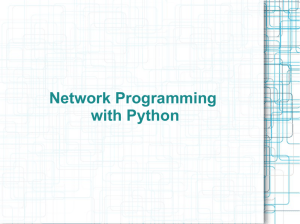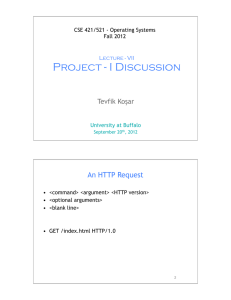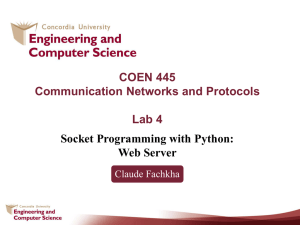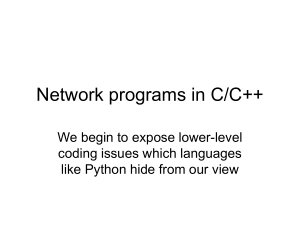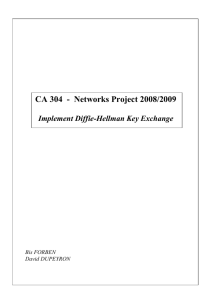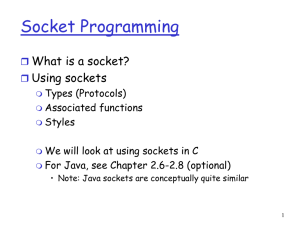host - USF Computer Science Department
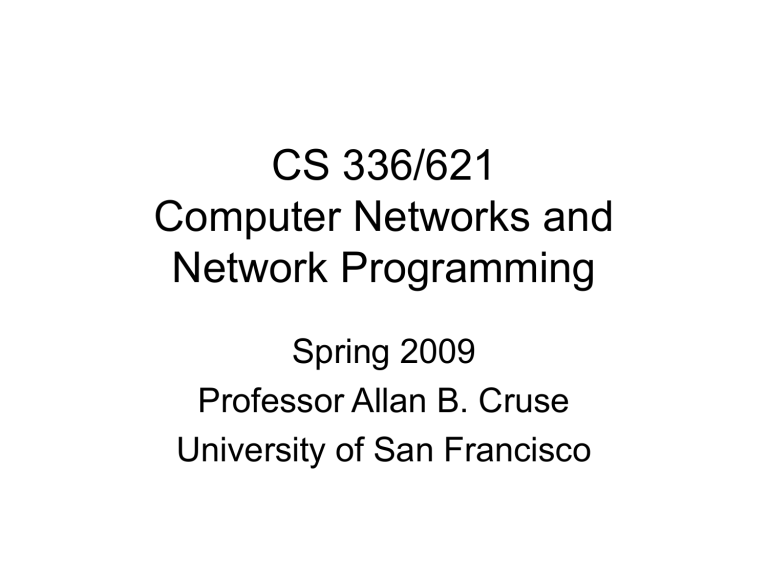
CS 336/621
Computer Networks and
Network Programming
Spring 2009
Professor Allan B. Cruse
University of San Francisco
Course synopsis
• Combines a survey of network principles with hands-on exercises and experiments
• Utilizes our classroom and CS laboratory networking hardware infrastructures
• Employs C/C++ programming language and the standard ‘sockets’ API libraries
Course prerequisites
• Open to USF Computer Science students
• Upper-division or graduate-level standing
• Familiarity with Linux (or UNIX) systems
• Programming experience: C/C++/Python
• Prior coursework: CS 110/112 and CS 245
(or the equivalent preparation elsewhere)
methodology
• Lectures
• Readings
• Discussions
• Demonstrations
• Exercises
• Projects
• Quizzes
Course website
• You will find current course-information at this website:
<http://cs.usfca.edu/~cruse/cs336>
• Reading-assignments, exam-dates, class announcements, course-related software, links to other resources and to the ‘signup’ page for our class’s online discussion-list
Textbook
• James F. Kurose and Keith W. Ross
• Computer Networking: A Top-Down Approach
• 4 th Edition
• Pearson/Addison-Wesley (2008)
This up-to-date textbook is very widely used in networking courses at colleges and universities in the United States and elsewhere.
Lots of material – maybe too much for one semester – the authors recommend we cover at least the first five chapters in sequence, then maybe one of the concluding chapters if time allows for that.
Reference Model
The textbook authors have utilized the standard reference model for networksoftware’s layered architecture as a principle which guides their “Top-Down Approach” to organizing the Chapters introduction application layer transport layer network layer link layer
Chapter 1
Chapter 2
Chapter 3
Chapter 4
Chapter 5
Network hardware elements
• NIC (Network Interface Controller)
• Cable (e.g., coaxial, fiber optic, twisted pair)
• Repeater (boosts signal-strength on long cables)
• Hub (promiscuously connects nearby NICs)
• Switch (selectively connects nearby NICs)
• Bridge (connects multiple network segments)
• Router (intelligently forwards network packets)
Network Interface Card (NIC)
Before the internet there was…
… sneaker-net!
host host
Users often would transfer their data from one computer to another by simply copying it onto a floppy diskette, and then carrying that diskette over to their other computer – located, hopefully, not too far away (e.g., just down the hall)
‘crossover’ cable
NIC host
NIC cable host
An improvement over the ‘sneaker net’ approach to data sharing between two host computers that are a short distance apart is to utilize a special direct cable connection – inexpensive to purchase, easy to connect if NICs are installed, less physical effort is required, no floppy disks are needed, and no risk of any unwanted ‘virus’ software infecting the host machines
A ‘Point-to-Point’ connection
repeater host host
Over a long-distance cable-connection the electrical signals can degrade, but ‘repeaters’ can be inserted to receive and amplify a weakened signal before sending it along (i.e., “repeating it”) to the next connection-point
‘Local’ networks
host host host host host
HUB host host
‘ring’ topology host
‘star’ topology
Why do you think the star-topology is more widely deployed nowadays?
host
‘Hub’ versus ‘Switch’
host host host host host host host host
Why are ‘switches’ preferred over ‘hubs’ nowadays?
The ‘Bridge’ device
switch host host host bridge switch host host host
The ‘Router’ device
switch router switch switch host host host host host host host host host
Network software elements
function library network application program
User-space operating system kernel
‘socket’ data-structure
File and I/O subsystems
(‘protocol stack’) device driver
NIC
Kernel-space cable
Demo: iplookup.py
• This application reports the IP- address for a particular network host (if it’s known)
• For example:
$ python iplookup.py
stargate
The IPaddress for ‘stargate’ is 138.202.171.14
$ python iplookup.py
pyramid
The IPaddress for ‘pyramid’ is 138.202.171.19
$ python iplookup.py
neptune
The IPaddress for ‘neptune’ is unknown
Source-code (in Python)
#!/usr/bin/python import sys try: hostname = sys.argv[1] except: hostname = “localhost” import socket try: hostip = socket.gethostbyname( hostname ) except: hostip = “unknown” print “The IP-address for \’” + hostname + “\’ is “ + hostip
Demo: getquote.py
• This internet application reports the latest price for a share of Intel Corporation stock
• For example:
$ python getquote.py
Intel Stock: $13.53 at “12:05pm” on “1/26/2009”
Internet programming
import socket try: host = “download.finance.yahoo.com” port = 80 sock = socket.socket( socket.AF_INET, socket.SOCK_STREAM ) sock.settimeout( 2 ) sock.connect( ( host, port) ) sock.send( “GET /d/quotes.csv?s=INTC&f=sl1d1t1c1ohgv&e=.csv \r\n” ) sock.send( “\r\n” ); response_string, server = sock.recvfrom( 4096 ) quote = str.split( response_string, ‘,’ ) except socket.error, msg: print “An error occurred:”, msg else: print print “Intel Stock: “, ‘$’+quote[1], “at”, quote[3], “on”, quote[2] print
In-class exercise #1
• Can you modify the ‘getquote.py’ program so that it will report the latest stock-price for some other famous technology firms?
– Microsoft Corporation
– Red Hat Corporation
– Oracle Corporation
– Siemens Corporation
– Sony Corporation

